

Haiku #102: by Jack Prewitt
First Published: The Dreaming Collection, 2008
Entry for: Slab Hut / Sporting Globe
Typical bush huts had vertical slab walls. Slabs were pit-sawn, or split with sledge and wedges and then smoothed with an adze.
picture courtesy of National Library of Australian
The slabs were often cut from green timber that shrank, or were milling offcuts. The gaps between slabs were often packed with newspaper such as the Sporting Globe (1922- ) a twice-weekly publication printed in Melbourne on pink paper and covering horse racing and football. It was a working man's paper.
Haiku #104: by Ross Clark
First Published:
Haiku #109: by Alma E Bird
First Published:
Haiku #111: by Sharon Dean
First Published: Yellow Moon, No 19 2006
Haiku #112: by Lorin Ford
First Published: Simply Haiku, Vol. 6, No. 3, 2008
Haiku #113: by Lyn Reeves
First Published: Yellow Moon
Haiku #115: by Max Ryan
First Published:
Haiku #116: by Ross Clatk
First Published:
Bondi Beach The 14 km City to Surf Fun Run (60,000+ entrants) held each August ends here.
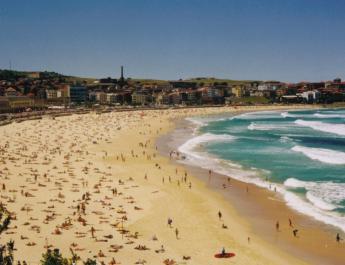
Australia's iconic surfing beach is Bondi (Boondi) in Sydney, NSW.
Other festivals include Festival of the Winds (kite flying) held each spring.
Haiku #119: by Lorraine Haig
First Published:
Haiku #121: by Rob Scott
First Published: First Australian Haiku Anthology - 1999
Haiku #124: by John Bird
First Published: Hobo Poetry Magazine, 1998
Haiku #125: by Lyn Reeves
First Published: paper wasp and Walking the Tideline by Lyn Reeves, Pardalote Press, 2001
Haiku #126: by Dhugal Lindsay
First Published:
[Editorial note: Dhugal composes his haiku in Japanese and translates them into English when needed.]
Haiku #128: by Vanessa Proctor
First Published:
Groper
The Eastern blue groper (Achoerodus viridis) is a large fish found in the southern, coastal waters of Australia, especially exposed reefs.


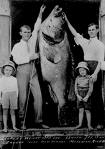
There are two species. Eastern blue gropers have been known to grow to 1.2 metres (4 ft) in length and weights of 22 kilograms. The western species is larger, reaching 1.6 m and 40 kg.
The blue groper is a member of the wrasse family and should not be confused with the Queensland gropers (Epinephelus).
Haiku #131: by Beverley George
First Published:
Mangroves
‘Mangroves are trees and shrubs that grow along sheltered intertidal shores, mainly in tropical amd subtropical coastal waterways. Australia has 39 mangrove species, which is more than half the global number.’ – OzCoast and OzEstuaries – for further reading and images about Australain mangroves.
Haiku #133: by Quendryth Young
First Published: Haiku Dreaming Australia 2006 [The Whole Body Singing March 2007]
Billabong
"A billabong ('bill-a-bong') is a body of water, like a large pond."
"A billabong forms when a river changes its course, leaving a section cut off from the new river. When the river floods every wet season, the water in the billabong flows again as it connects up with the main river. Because of this the water stays fresh and supports an abundance of life." more from Questacon

Haiku #134: by Graham Nunn
First Published:
Haiku #136: by Jack Prewitt
First Published: Haiku Dreaming Australia, 2006
Haiku #139: by Alma E Bird
First Published: Stylus No2, 2002
Haiku #141: by Lyn Reeves
First Published:
Haiku #144: by Vanessa Proctor
First Published:
Haiku #145: by Janice M Bostok
First Published: Amongst The Graffiti, Janice M. Bostok, 2003
Haiku #146: by Max Ryan
First Published:
Haiku #147: by Janice M Bostok
First Published: Amongst The Graffiti, Janice M. Bostok, 2003
Hills Hoist -- a rotary clothes hoist
"It was popularised in Australia by Lance Hill and is a common sight in Australian and New Zealand backyards. It is considered one of Australia's most recognisable icons, and is used frequently by artists as a metaphor for suburbia in Australia." [ Wikipedia]
and see GNT History
The "Hills Rotary Hoist" become an emblem of Australian enterprise.
Haiku #148: by Vanessa Proctor
First Published:
Haiku #151: by Lorin Ford
First Published: World Haiku Review - Treetops, Vol 5, issue 1, 1/09/2005
Haiku #154: by Maureen Sexton
First Published:
Haiku #155: by Ross Clark
First Published:
Haiku #157: by Sunil Uniyal
First Published:
Haiku #159: by Janice M Bostok
First Published: Amongst The Graffiti, Janice M. Bostok, 2003
Haiku #160: by Bett Angel-Stawarz
First Published:
Haiku #162: by John Bird
First Published: From the sequence The Long Paddock first published in Songs of the Unsung Heroes, 2002, Australian Workers Heritage Centre.
Swag/Swaggie
A swag (Australian slang) is a bedroll carried by a swaggie, an itinerant/hobo; and an Australian icon. A swag was also known as a bluey, as in "hump the bluey", and as a matilda, as in the song Waltzing Matilda.See entry in Wikipedia.
The Long Paddock -- a stock route or open road where people too poor to own paddocks, or any cattleman in times of drought, could drove their stock to graze them.
Haiku #163: by Myron Lysenko
First Published:
Haiku #163: by Quendryth Young
First Published: maple leaf, Jack Stamm anthology 2006/2007
rivergum — more fully, a 'river red gum', Eucalyptus rostrata or Eucalyptus camaldulensis, which mainly grow along rivers and dried-up water courses; a source of strong timber.
bushie — a bushman of sorts; the 'swag' identifies him as a swaggie'.
Haiku #165: by Jo McInerney
First Published:
Haiku #116: by Jo McInerney
First Published:
Entry for: Lake Eyre / saltpan
Lake Eyre ia an example of a saltpan or shallow salt lake. In the centre of Australia, it is the largest and saltiest lake in the country and the lowest point on the continent (15m below sea level). The surface of salt crust covers 9323 square kilometers. It's normally a dry saltpan but a 4m flood occurs about every decade, and it neary fills four times a century.
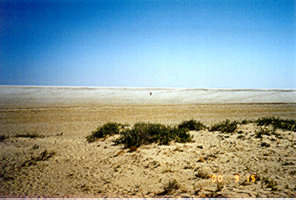
The water brings the breading of thousands, if not millions of pelicans, banded stilts, silver gulls and many other water birds. Pelicans can detect ultrasonic signals from lightning, which explains how they find this inland sea.
Haiku #168: by John Bird
From the sequence, The Fence Rider, published in Banjo Paterson Awards, 2006
Haiku #169: by Ron Moss
First Published:
Haiku #173: by Jyotimitra
First Published:
Entry for: Nullabor
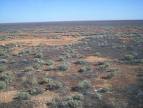
"The Nullarbor Plain is part of the area of flat, almost treeless, arid or semi-arid country immediately north of the Great Australian Bight. It is the world's largest single piece of limestone, and occupies an area of about 200,000 km². It stretches about 1,200 km from east to west between South Australia (SA) and Western Australia (WA)." -- from Wikipedia
"'Crossing the Nullarbor', for many Australians, is a quintessential experience of the 'Australian Outback'. Stickers bought from roadhouses on the highway show 'I have crossed the Nullarbor'"
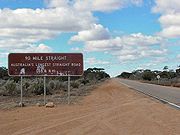
Haiku #175: by Ron Moss
First Published:
Entry for: Camp Oven
The original camp oven was a cast iron pot with three short legs and an iron lid. It was used by early settlers and rural workers to cook damper (bread), roasts, stews and a wide range of other dishes. The oven was hung over an open fire or placed in its embers.
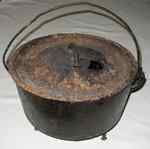
Haiku #176: by Vanessa Proctor
First Published:
Haiku #177: by Alan Summers
First Published:
Haiku #178: by Ian Iwaszkiewicz
First Published:
Haiku #179:
First Published:
Waratah
A brilliant red flower, blooms in spring, floral emblem of the state of New South Wales.
the toréador song is from Georges Bizet's opera Carmen.
Please use "Back" button to return to haiku.
Haiku #181: by Quendryth Young
First Published: Stylus July 2006 (as 'seaside banksia') [The Whole Body Singing March 2007]
Entry for: Banksia - shades of dying
Sixty species of Banksia (plant family Proteaceae), native to Australia, are found in all but arid regions. Their showy flower heads range from yellow to red and they start blooming in autumn. During winter the one tree can have flower heads in many stages of dying, down to hairless black cones.
Please use "Back" button to return to haiku.
Haiku #183: by Bea Holmes
First Published:
Entry for: Wattle
Wattle ( Acacia pycnantha, Golden Wattle) is the national floral emblem of Australia.
1 September (the first day of spring) is officially 'National Wattle Day' but in most areas wattle blooms in late winter and is spoken of as 'the barbinger of spring'. Further reading
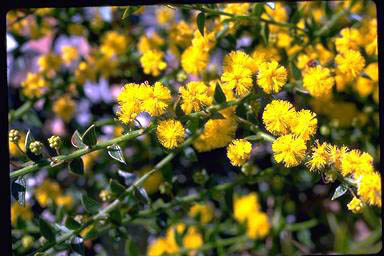
Acacia ambylgona
'Winter Gold'
Photographer: M Fagg
Image courtesy of and ©
Australian National Botanic GardensMore than 900 species of Acacia make it the largest genus in the Australian flora.
Please use "Back" button to return to haiku.
Haiku #188: by Lyn Reeves
First Published: Famous Reporter
Please use "Back" button to return to haiku.
Haiku #189: by Quendryth Young
First Published: The Dreaming Collection 2006; [The Whole Body Singing March 2007]
Entry for: NSW Christmas Bush (Ceratopetalum gummiferum)
Ceratopetalum gummiferum is widespread over the east coast of New South Wales, commonly growing in open forests and on sandstone hillsides. [Plants known as "Christmas Bush" in other states are quite different species.]
About the end of October (spring), when clocks are reset for daylight-saving time, the first flush of pink appears. By the end of December the plant puts on a great display of red 'flowers'.
Please use "Back" button to return to haiku.
Haiku #192: by Allison Millcock
First Published:
Please use "Back" button to return to haiku.
Haiku #195: by Lorin Ford
First Published: Frogpond, Winter 2007(Feb)
Please use "Back" button to return to haiku.
Haiku #196: by Dhugal Lindsay
First Published:
[Ed: the Japanese is reproduced here because initially, Dhugal makes his haiku in that language.]
Please use "Back" button to return to haiku.
Haiku #198: by Lesley Dewar
First Published:
Please use "Back" button to return to haiku.
Haiku #199: by Dhugal Lindsay
First Published:
Please use "Back" button to return to haiku.
Haiku #200: by Myron Lysenko
First Published:
Please use "Back" button to return to haiku.